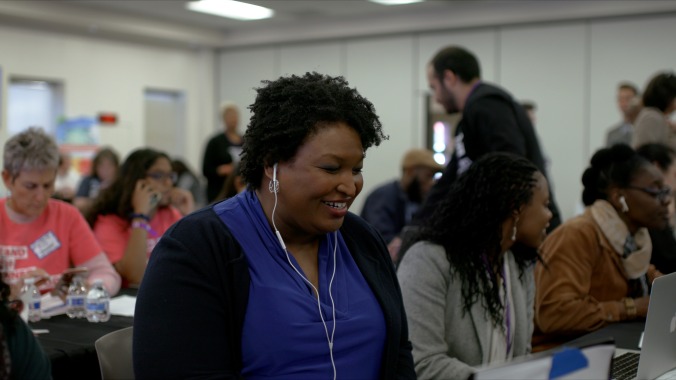The alarming documentary All In offers a possible preview of November’s election

Note: The writer of this review watched All In: The Fight For Democracy from home on a digital screener. Before making the decision to see it—or any other film—in a movie theater, please consider the health risks involved. Here’s an interview on the matter with scientific experts.
The agitprop documentary All In: The Fight For Democracy presents itself as an urgent dispatch from the frontlines of the voting wars. The movie is so up to date that its opening minutes include footage from the summer of 2020, referencing both the state primaries that have taken place during the COVID-19 pandemic and President Trump’s recent warnings that enforcing existing voting laws could be catastrophic to Republicans. The bulk of the story that directors Lisa Cortés and Liz Garbus are telling has its roots in the past 150 years of American history, from the immediate aftermath of the American Civil War to the dawn of the civil rights movement. But more than anything, All In is the story of the rise of Black, Latinx, Asian, indigenous, and young adult participation in American democracy—and of how the powers that be have scrambled to change the rules of the game to keep those blocs from winning.
The most persuasive voice in All In belongs to Stacey Abrams, the former Georgia gubernatorial candidate whose close 2018 loss to Brian Kemp—the man who was, at the time, in charge of the voting process in the state—raised a higher-than-usual state of alarm among those who’ve been tracking the recent decay in our democratic institutions. Abrams herself refused to concede that she’d lost, pointing to the myriad constitutionally questionable ways that Kemp made it easier for his supporters to vote and harder for hers, including reducing polling stations and auto-purging registration rolls. Much of All In’s final third—the film’s most gripping section—details how Abrams worked extra-hard to get out the vote, while all the most egregious voter-suppression tactics were brought to bear by her opponent.
Throughout, Cortés and Garbus use Abrams’ case as a frame, starting with a moment where Abrams discusses her personal experiences as a Black woman growing up in Georgia, seeing her credentials questioned and her opportunities curtailed. All In’s central argument is that the advances made during the civil rights movement are being rolled back across the country perhaps because, ironically, the narrative surrounding public figures like Abrams has changed. Successes like hers are now often held up—disingenuously, depending on who’s doing the holding—as an example of the end of systemic racism, not as an example of someone battling to overcome it.
The larger story All In tells about the difficult process of making American democracy more democratic is supported by archival footage, personal anecdotes, and a lot of dot-connecting between different recent national news stories, from the rise of local authoritarians like Sheriff Joe Arpaio to the multiple recent Supreme Court cases dealing with gerrymandering and ballot access. Cortés and Garbus draw a line between Jim Crow America, which has been the backdrop to so many feel-good stories of civil rights triumphs, and the America of today, which seems to be retreating rapidly to that past.
Frankly, All In would be better if it were less expansive. A more straightforward bio-doc about Abrams, with extended digressions about the larger history behind her voting rights activism, might’ve been more powerful. Instead, the absence of one clear narrative through-line makes the movie feel more like an aggregation of alarming incidents than the richer piece of contemporary journalism it should be. All In is still plenty effective, but it lags behind the likes of social media and late-night comedy shows, which have presented a lot of this same information in packages that are more emotional and entertaining.
That said, the film does have real resonance, even beyond its original intention of promoting voting and cautioning about voter suppression. This summer of unrest has been a reminder that the United States has for decades grappled with—and failed to resolve—questions about who really gets a voice in the grand democratic experiment. In All In, clips of President Lyndon Johnson in the mid-’60s calling for a reckoning with “the crippling legacy of bigotry” and right-wing pundit Ann Coulter just a few years ago calling for the return of Jim Crow voting restrictions is a reminder that no matter how far we’ve come, we can always turn back.